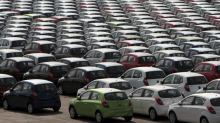India's wheels of fortune
 So far, economic development in the world’s largest democracy has focused on services more than manufacturing. But India needs balance and car makers provide an example to follow.
So far, economic development in the world’s largest democracy has focused on services more than manufacturing. But India needs balance and car makers provide an example to follow.India’s manufacturing sector makes up only 16 per cent of its GDP. This needs to increase if the country is to find jobs for its huge population. Yet on the back of strong domestic demand, global car manufacturers have flocked to India and are helping to make the sector globally competitive – particularly in small cars. Capacity is expected to increase from 4.8 million units in 2010 to 12 million in 2018 according to Rothschild. India is set to become the third-largest auto maker in the world and could become a major exporter.
Small cars make up 70 per cent of the domestic market. And although Tata and Mahindra provide strong local competition, foreigners are dominant. Foreign direct investment (FDI) into the automotive industry increased by 48 per cent to $7.4-billion in 2011, according to Ernst & Young. Suzuki alone has a 45-per-cent share.
With no caps on FDI, new entrants are spurring competition. And in contrast to recent policies on retail, state governments have been welcoming. Clusters are being created in the south and west of India where states such as Tamil Nadu and Gujarat offer cheap land to attract investment.
But it’s not just the domestic market that is fuelling growth. Exports already make up 15 per cent of output, and many firms have ambitions to develop the international angles. Hyundai uses India as the global source point of all their small cars. Last year it exported 247,000 cars from India – almost double the 2007 figure. Ford is stepping up export of Indian cars to over 50 countries. And Toyota says it plans to export cars to South Africa in March, 2012, the first time it will ship Indian-made cars overseas.
Infrastructure bottlenecks, skills shortages and slow-moving bureaucracy pose big challenges to India’s manufacturing development. But as labour cost in China rise, India has an opportunity to win market share. In autos, it may have found a formula that can be replicated.
You can return to the main Market News page, or press the Back button on your browser.

